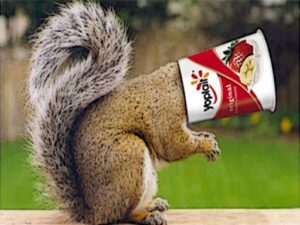Plastic in the Air
You may have heard about oceanic plastic pollution – marine animals choked by six-pack rings, stomachs filled with plastic debris, the “Great Pacific Garbage Patch”, – according to IUCN an estimated 8 million tons a year flow into the ocean accounting for 80% of all marine debris.
But not all plastic pollution ends up in the ocean. Microplastics and nanoplastics (too small to see with the naked eye) have migrated – by air and water – to every part of our planet.
Plastic that is not recycled does not disintegrate. It can be stored in a landfill, but if not repurposed it persists. Whether discarded in 1970 or 2020, plastic from discarded toys, auto parts, plastic bags, and every other source, slowly breaks down into smaller pieces of plastic called micro plastics, but they are still chemically plastic, and do not biodegrade.
In addition to plastics from the obvious sources, they are also used in microfibers. These fibers typically come off of clothes such as polyester, nylon, and acrylic, along with microfiber cloths. This includes nonstick skillets and wrinkle free clothing. Every single time a piece of wrinkle free clothing is washed, it sheds hundreds to thousands of small fibers, which are not filtered out at your local wastewater treatment plant.
The plastic that is not landfilled and not recycled enters the environment where it is a threat to wildlife. Animals can  become entrapped in larger pieces (Yoplait yogurt containers, for example, are notorious for trapping animals because of their inward-curving shape). They can also choke on smaller pieces, where it may fail to pass through their intestines and cause starvation by blocking the digestive system. Plastic is toxic because of its chemical makeup which includes exotic chemicals used to hold the plastic together or to provide it with flexibility, and these toxins can cause endocrine and hormone disruption.
become entrapped in larger pieces (Yoplait yogurt containers, for example, are notorious for trapping animals because of their inward-curving shape). They can also choke on smaller pieces, where it may fail to pass through their intestines and cause starvation by blocking the digestive system. Plastic is toxic because of its chemical makeup which includes exotic chemicals used to hold the plastic together or to provide it with flexibility, and these toxins can cause endocrine and hormone disruption.
Of course, plastics in the environment are also dangerous for human health and safety as they travel up the food chain and are consumed by people who fish and hunt. In addition, nanoplastics (too small to be filtered out during the water treatment process) enter streams and water supplies.
Microplastics and nanoplastics are everywhere – spread by wind and water. They have been found in remote areas of pristine National Parks. They are light enough to get caught by the wind and are carried for miles. They can wash ashore or get caught during a flood, then when the water dries the fiber can become airborne, or they can aerosolize out of the ocean. These airborne fibers are turning up everywhere, which means everyone is breathing them in. To read more on microplastics, click here.
So what can you do?
The most obvious answer to this question is to be sure to separate and recycle your plastic waste along with other waste to keep it out of landfills. Recycling may be difficult to locate in some parts of the state, but once you find a drop off point and get in the habit of recycling it will be an easy practice to follow. Remember that some types of plastic (like thin bags) are not processed by traditional recycling centers – so you will need to collect them at your house and them drop them off at a pickup center (often found in the entry way to grocery stores and other businesses). Batteries should also be recycled, and usually a collection point can be found at larger appliance or hardware stores.
But recycling is not the only solution, and it doesn’t truly address the issue of plastic overuse. Most plastic cannot be recycled, and even when it is it must be blended with virgin plastic and/or results in a lower quality product which often can’t be recycled a second time. So you can take a few additional practical steps:
- Avoid single-use plastic – take cloth bags with you when shopping, and say no thanks to the plastic bags.
- Minimize cooking with Teflon and other non-stick surfaces – suing steel, aluminum or cast iron will reduce the amount of microplastic that you eat with your food, and the amount entering the water system when the dishes are washed.
- Avoid “wrinkle free” clothing when you can – you’ll find the fabrics breathe better, so you’ll be more comfortable, and a few wrinkles are an easy trade-off for protecting aquatic animals and our drinking water supply.
- When buying takeout food, say “no thanks” to the plastic forks and straws when you can (or get a reusable straw to carry with you) – certainly if you’re carrying it home where you already have forks and spoons.
- When taking leftovers home from a restaurant, ask that they be wrapped in aluminum foil and not plastic.
- Carry a reusable coffee cup with a sturdy lid so when you buy coffee to go you can avoid the plastic or paper waste – you will find that many stores offer a discount and treat your reusable cup as a “refill”.
I invite you to join me in Plastic Free July, and challenge yourself to refuse at least one type of single-use plastic for the month of July and onward. Anyone can do it. Say “no thanks” to single use plastics such as glitter, straws, wet wipes (which are never flushable), plastic or Styrofoam cups, plastic bags, and single use plastic cutlery. These are easy items to replace with reusables, and to find out more visit plasticfreejuly.org.
Katie Wiesehan
Land Learning Foundation Biologist